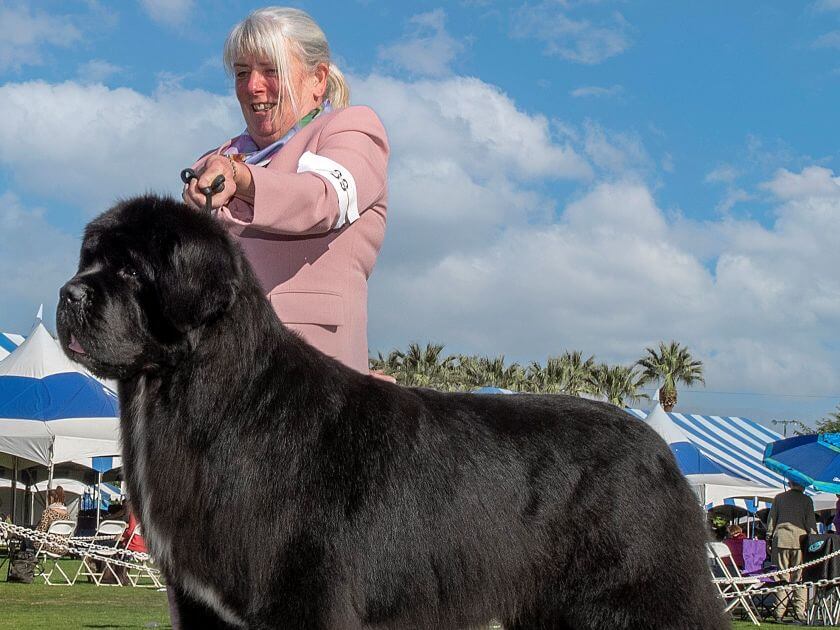


Home » Ingrid Lyden | Nakiska Newfoundlands

Ingrid Lyden: I live in Auburn, Washington, and have had Newfoundlands for over 36 years, but I’ve had dogs in my life since I was born, many years before that! My first litter was born 33 years ago.
Ingrid Lyden: My kennel name is Nakiska Newfoundlands and I usually keep 6-10 Newfoundlands.
Ingrid Lyden: Our dogs live together and they live in our home. Several sleep in the bedroom or in the large recreation room. They also spend much of the daylight hours outside in runs and/or in large fenced paddocks. They are family pets, first and foremost.
Puppies are whelped and raised in the house. Sometimes C-sections are needed for whelping. They are watched 24/7 for the first three weeks of life and then receive constant attention and care. We use many aspects of the Puppy Culture program and invite visitors of all ages into our home to socialize the puppies. The puppies start to enjoy the outdoors by about four weeks of age, but continue to be both inside and outside until they go to their new homes. This typically happens at about 10 weeks of age.
Ingrid Lyden: I don’t have a set process. Puppies are watched and handled from the day they are born until they go to their homes, and then, whenever I can continue to see them in person or via pictures. Puppies need to possess breed type, correct movement, and proper temperaments to show. I often make videos of the puppies and share them with other breeders for input.
When possible, I ask other breeders, not just of Newfoundlands, to come and go over the litters to provide more in-person input. Showing is also a performance, so I don’t typically look to pick a puppy just for performance, although if a potential owner is hoping to do more working events then perhaps we discuss the personality of the puppy a bit more. In Newfoundlands, I find that a good deal of the success in most of our performance events (particularly Water and Draft Work) is the result of the dedication to training of the owner and the team they make with their dog.
Ingrid Lyden: Over the years I have done Obedience, Water, and Draft Work with many of our dogs. I particularly enjoy the Water Work. Many of our dogs have earned the Newfoundland Club of America VN “Versatility Newfoundland” title which requires a breed championship, two levels of Water Work, a Draft title, and a CD or beyond in Obedience.
Ingrid Lyden: Not really, unless we are talking about the overall “performance” a dog does living their daily life.
Ingrid Lyden: Newfoundlands need to be in good shape and proper weight. They should have excellent muscle tone, which can be achieved through good exercise such as fast walks, free exercise in the paddock, swimming and the like. They should all be fit working dogs.
Ingrid Lyden: Like all giant breeds, orthopedic issues are a problem, including cruciate ligament tears. All breeding animals should be screened for hips and elbows. Heart disease, particularly sub-aortic stenosis, is a problem in Newfoundlands, and all puppies and breeding adults should be screened by a board-certified cardiologist. Cystinuria status should be determined prior to any breeding. Other issues can be problematic, and excellent vet care is essential to a healthy dog and a good breeding program. I don’t think there are special nutritional needs, but feeding a high-quality diet is important.
Ingrid Lyden: No.
Ingrid Lyden: Newfoundlands, typically, are great family dogs. It is important to train from an early age, as you don’t want a 25-pound puppy doing something that you don’t want your 140-pound adult doing down the road! The best candidates are people who don’t mind drool, lots of dog hair everywhere, loud snoring, and spending lots of money and time with their dog! Newfs want to be with their owners!
Ingrid Lyden: What is my breed’s best-kept secret? I think many people believe Newfs are couch potatoes and very laid-back. Some are, but many are not. An active 140-pound dog is very different to live with than an active 40-pound dog. Their best-kept secret is also that these giant dogs love to cuddle like a little lap dog and can fit into a very small space to make this happen!
Ingrid Lyden: I am also an AKC licensed judge for Newfoundlands and on the NCA Judge’s Education Committee. So, judges, please look for type first. Have a very good idea of what an ideal Newfoundland should look and act like: large, soft expression, heavily coated, heavy bone, well balanced, sweet disposition, powerful, well balanced, and muscular. Judges need to please put their hands on every Newfoundland they judge. You must feel through the coat on the dog in order to discern what’s there. When the dog moves, do the parts stay together?
Ingrid Lyden: Breeding is not easy! It can bring great joy and it can also bring huge sorrow. Be sure you have a team to help you. You need mentors and you need excellent access to veterinary care. Do your homework and ask lots of questions to those breeders with more experience.
Ingrid Lyden: I can think of two. Once, when exhibiting my dog “Numphrey” in a water test, he decided to speak his opinion about having to be pulled away from the girls in season at home, and stood and barked loudly for a full minute with his bumper in his mouth the entire time! Another time, I was showing my special, and on the down & back my skirt fell completely to the ground. Thankfully, the judge was kind enough to hold my lead while I put my skirt back on.